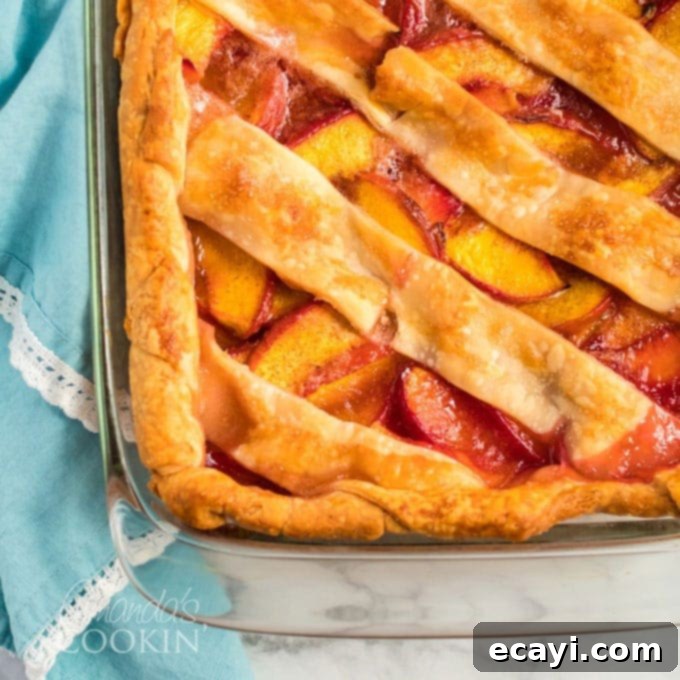The Best Homemade Deep Dish Peach Pie Recipe: A Timeless Family Favorite
This homemade deep dish peach pie recipe holds a special place in my heart, brimming with cherished memories. I vividly recall my mom preparing this very pie when I was a little girl. I can still picture her in the kitchen, her well-worn cookbook open, meticulously mixing the dough, expertly slicing fresh peaches, and offering me a warm smile as I sat patiently at the table, eagerly awaiting a taste of her culinary magic.
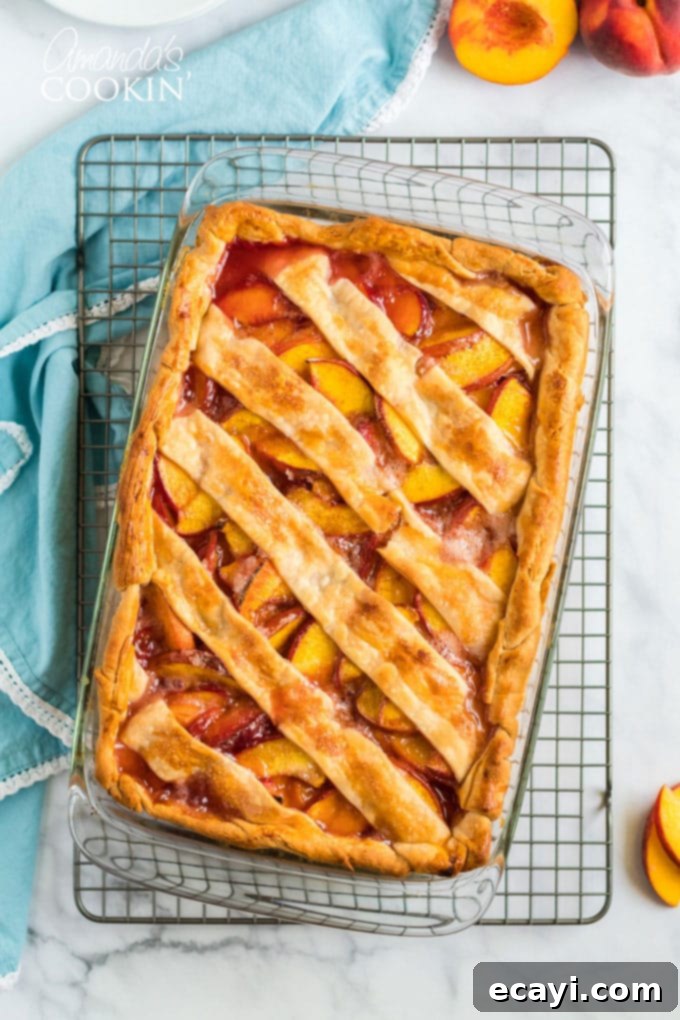
There’s something uniquely comforting about a classic fruit pie, and this deep dish peach pie, a treasured family recipe passed down from my mom, is no exception. While I adore many fresh fruit pies, like this delightful blueberry pie, none evoke such sweet, nostalgic memories quite like this particular peach pie. It’s more than just a dessert; it’s a taste of home, a tangible link to precious moments spent with my mother.
Why This Homemade Peach Pie Recipe Will Become Your New Favorite
If you’ve never experienced the unparalleled joy of a truly homemade fresh peach pie, you are truly missing out on a quintessential summer delight. The secret to the best peach pie lies in using fresh, perfectly firm peaches, thinly sliced with their skins left intact. This simple detail contributes to both flavor and texture, offering a rustic charm that store-bought pies simply can’t replicate.
Some bakers might argue for peeling the peaches, fearing the skins could impart a bitter taste. However, in my many years of making this recipe, I’ve never encountered such an issue. The skins soften beautifully during baking and add a subtle depth of flavor and a lovely visual appeal. That said, if your personal preference is to peel them, please feel free to do so; it won’t diminish the incredible taste of the peach pie filling.
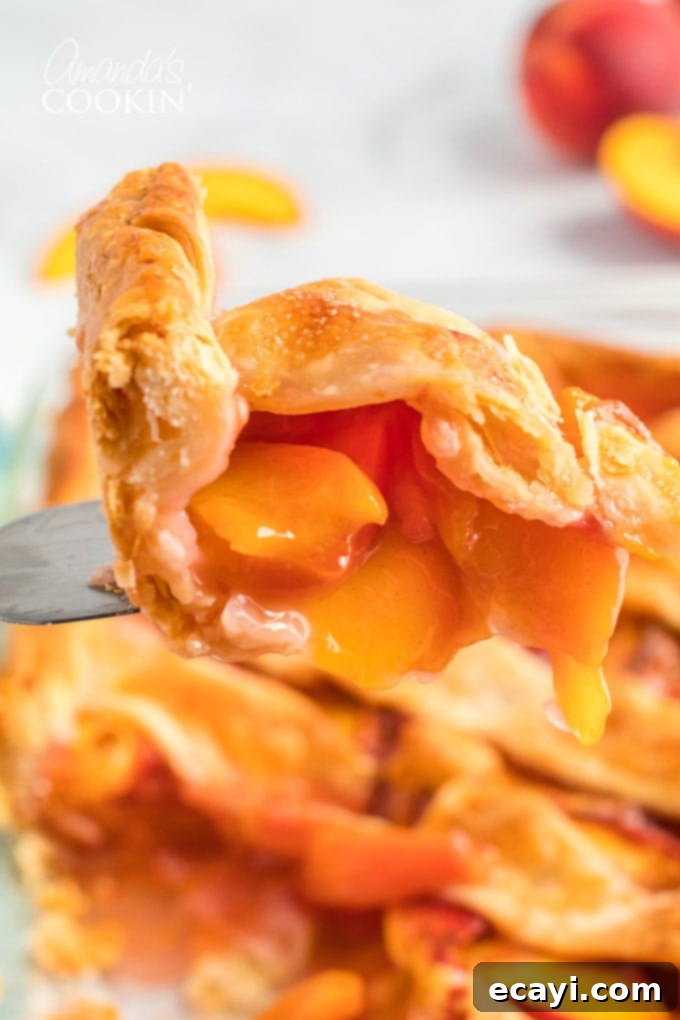
The magic happens when fresh, thinly sliced peaches are perfectly married with just the right amount of sugar and a touch of cinnamon. This combination creates a rich, sweet, and slightly spiced filling that allows the natural peach flavor to truly shine. And the aroma that wafts from the oven as it bakes? It’s utterly mouth-watering, guaranteed to make your tastebuds tingle and your stomach growl in anticipation.
Mom’s Original Deep Dish Peach Pie: A Family Legacy
My mom originally discovered the foundation for this fresh peach pie recipe in her all-time favorite culinary companion, The Good Housekeeping Illustrated Cookbook. Over time, she made a few thoughtful modifications to perfect it, turning it into the beloved deep dish peach pie we enjoy today. Her most notable adjustments included increasing the dough ingredients to achieve a thicker, more substantial crust – a preference she felt improved the pie’s overall structure and flaky texture. She also experimented with the topping design, moving beyond the simple to create a more robust and visually appealing crust.
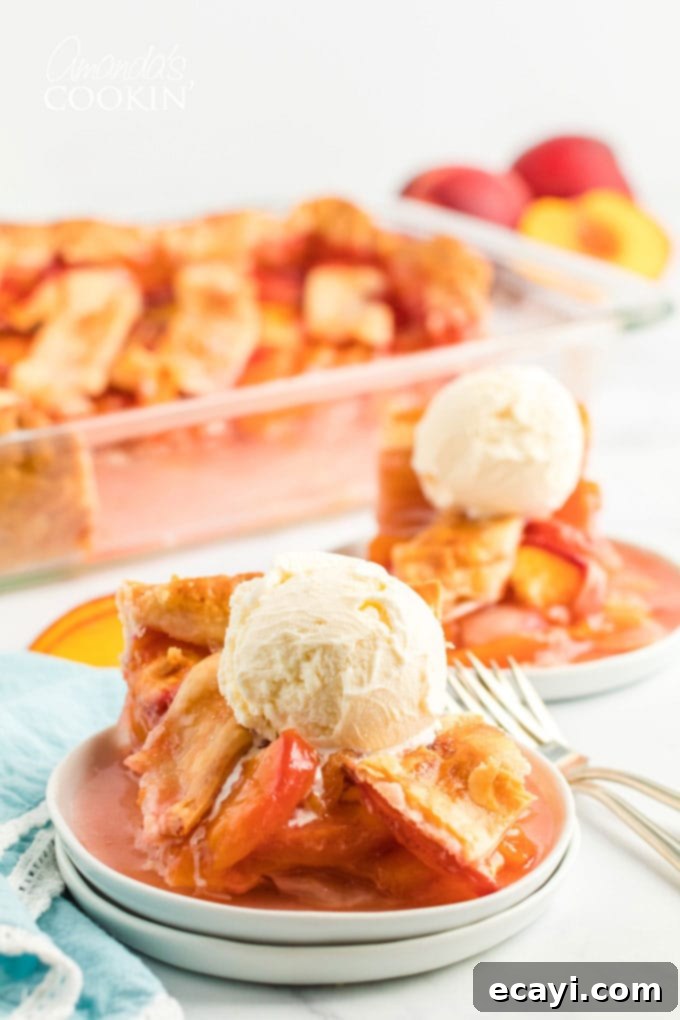
So, if you’ve been searching for the ultimate homemade peach pie recipe using fresh peaches, your quest ends here. This isn’t just any pie; it’s a generous deep dish pie, baked in a 13×9 inch pan, making it absolutely perfect for feeding a crowd. Its impressive size and delicious flavor make it an ideal dessert for holidays, large family gatherings, potlucks, or any occasion where you want to impress. Be prepared to share the recipe, because trust me, you will be asked for it!
Essential Ingredients for Your Delectable Peach Pie
For all precise measurements, a complete list of ingredients, and detailed step-by-step instructions, please refer to the printable recipe card conveniently located at the end of this post.
- You’ll need high-quality white granulated sugar to sweeten the luscious peach filling. This is crucial for balancing the peaches’ natural tartness and creating that classic sweet pie taste. I’ve always used granulated sugar in this recipe; if you decide to experiment with substitutes, please let me know your results!
- Cornstarch serves as the essential thickening agent for the pie filling. It ensures your peach pie has a perfectly set, not watery, consistency that holds its shape beautifully when sliced. Unlike flour, cornstarch creates a clear, glossy filling, allowing the vibrant color of the peaches to shine through.
- Cinnamon is the sole spice used in this recipe. Its warm, sweet notes perfectly complement the peaches without overpowering their delicate flavor, ensuring the fresh taste of the fruit remains the star of the show.
- A small amount of regular table salt is incorporated into both the filling and the crust. This isn’t just for flavor; salt is a crucial ingredient in baking that enhances all the other flavors, making them more pronounced and well-rounded.
- The most important ingredient: roughly 5 pounds of fresh peaches. Plan to purchase them the day before or on the day you intend to bake your pie. It’s vital to select very firm fruit that yields only slightly to the touch. This firmness is key for several reasons: firmer peaches are much easier to slice neatly, and more importantly, riper and softer peaches release significantly more juice during baking. This can easily lead to an undesirable watery pie filling, which is exactly what we want to avoid for a perfectly set pie.
- I consistently use unsalted butter in all my baking recipes, and this peach pie is no different. Unsalted butter allows you complete control over the salt content in your dish. While salted butter can be used in a pinch, be aware that it might subtly alter the overall flavor profile. I strongly advise against using margarine for the pie crust, as it won’t achieve the same wonderfully flaky, rich texture that butter or shortening provides. However, if it’s your only option, it can technically be used successfully, but the results won’t be as superior.
- For the crust, all-purpose flour is your go-to. Whether bleached or unbleached, either will work perfectly. Unless you have extensive experience working with alternative flours for pie crusts, I recommend sticking with all-purpose for consistent, reliable results.
- I prefer to use butter-flavored shortening for this pie crust, as it imparts a delicious flavor while contributing to an exceptionally flaky texture. Regular shortening will also work wonderfully. There’s a long-standing debate among bakers about whether shortening (or even lard) truly makes the flakiest pie crust compared to butter, thanks to its higher melting point. If you staunchly prefer butter, you can substitute an equal amount of cold, diced butter for the shortening, though the texture might vary slightly.
- Cold or ice water is sprinkled into the dry ingredients to bring the crumb mixture together and form a cohesive dough. Using very cold water helps keep the shortening or butter solid, which is essential for developing those desirable flaky layers in the crust.
- For an extra special touch, you can add a beautiful sugar coating to the crust. Simply brush the top lightly with an egg wash (beaten egg with a splash of water) and then sprinkle generously with granulated sugar just before the pie goes into the oven. This creates a shimmering, slightly crunchy finish.
Helpful Kitchen Tools for Pie Perfection
- 13×9 inch glass baking dish: The perfect size for this deep dish recipe.
- Rolling pin: Essential for achieving an even, perfectly rolled crust.
- Pastry blender: Ideal for cutting fat into flour, ensuring a flaky crust. Two knives can also work in a pinch.
- Pastry wheel or pizza wheel: Makes cutting uniform strips for the top crust quick and easy.
Expert Tips Before You Begin Baking Your Homemade Peach Pie
- Always buy a bit more peaches than you think you’ll need. Aim for around 5 pounds of fresh peaches. While you might not use every single one, it guarantees you’ll have enough to reach the required 10 cups of sliced fruit for this recipe. Peach sizes vary greatly, so having extra ensures you won’t run short. For reference, the last time I made this pie, 3.5 pounds of peaches yielded exactly 10 cups of sliced fruit.
- Embrace the rustic charm of this crust. This recipe naturally lends itself to a beautiful, homemade, rustic appearance. However, if you prefer a more refined look, you can easily create a decorative fluted edge with your fingers around the rim of the pie. For an even more intricate presentation, consider making a classic lattice topping by cutting the top strips of pie dough into thinner pieces and weaving them into a beautiful pattern.
- Resist the urge to open the oven door while baking. It’s crucial to let your deep dish peach pie bake undisturbed. Opening the oven frequently causes significant temperature fluctuations, which can negatively impact the crust’s flakiness and the filling’s setting. The crust typically browns beautifully and quickly, but in my experience, it rarely burns. If you know your oven tends to run hot, or if you notice the edges of the crust browning too rapidly, you can carefully remove the pie from the oven for a moment. Then, gently cover *only* the edges with strips of aluminum foil to prevent over-browning. Absolutely do not cover the entire top of the pie with foil, as this will trap steam, causing the crust strips to collapse and preventing the filling from thickening properly.
- Patience is key for perfect slices. For a firmer pie that is significantly easier to cut into neat, beautiful slices, allow the pie to cool on a wire rack for at least 2 hours after baking. This cooling period is essential for the filling to fully set. If you prefer to enjoy a warm slice, individual servings can be easily reheated in the microwave for a short burst.
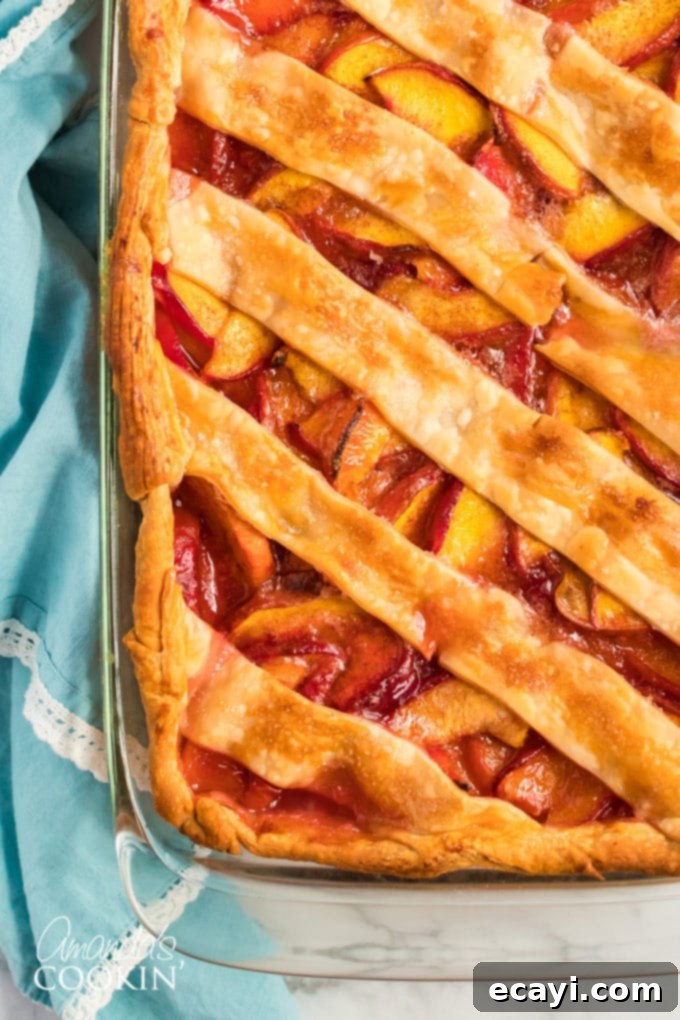
Step-by-Step Guide: How to Make the Best Deep Dish Peach Pie
The journey to a perfect peach pie begins with crafting the crust. For this recipe, we won’t be par-baking the crust; instead, the filling will be added directly to the raw dough, allowing it to bake together for a harmonious result.
These step-by-step photos and detailed instructions are provided to help you visualize each stage of making this recipe. For a concise, printable version of the recipe, please scroll down to the end of this post!
Making the Perfect Flaky Pie Crust
Before you begin, prepare your workspace. Set out your 13×9 inch glass baking dish, but remember, there’s no need to grease the pan. The rich shortening in the crust will prevent sticking.
- In a medium-sized mixing bowl, combine the all-purpose flour and salt. Use a fork to stir them together thoroughly, ensuring an even distribution of salt throughout the dry ingredients. This forms the essential base for your flaky crust.
- Next, it’s time to incorporate the shortening. Add the butter-flavored shortening to the flour mixture. Using a pastry blender (or two knives held scissor-style), cut the shortening into the flour. Work quickly until the mixture resembles coarse crumbs, with some larger pea-sized pieces of shortening still visible. These small pockets of fat are what create the incredible flakiness in your baked crust.
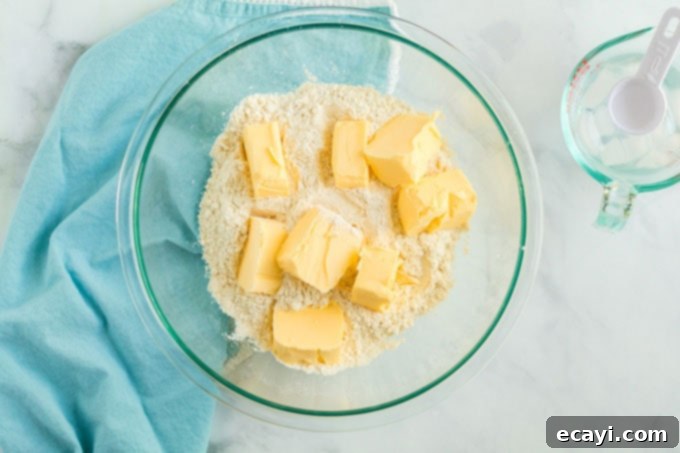
- Now, gradually introduce the cold water, adding it a tablespoon at a time. After each addition, lightly mix the dough with a fork. Continue adding water and mixing until the dough just barely comes together and holds its shape. Be careful not to overmix, as this can develop the gluten too much, resulting in a tough crust. The key is minimal handling.
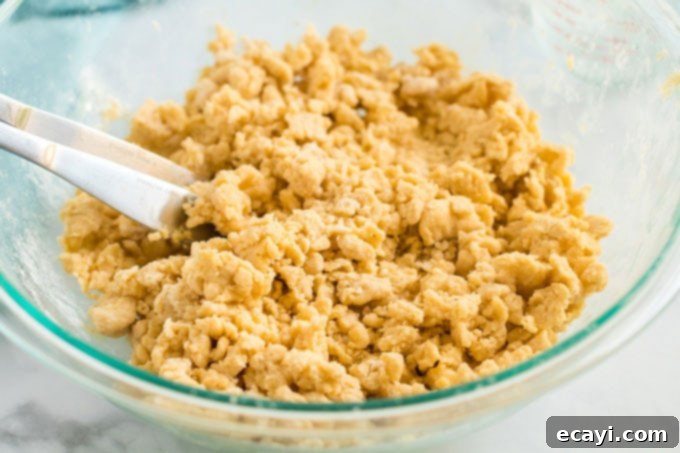
- Once the dough has come together, gently shape it into a cohesive ball. Then, cut off approximately one-fourth of the dough and set it aside. This smaller portion will be used for the top crust strips later.
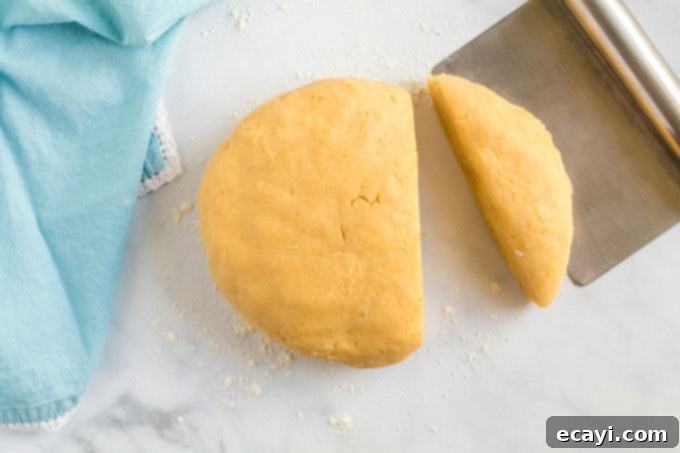
- Lightly flour a clean work surface and your rolling pin. Take the larger three-fourths portion of the dough and roll it out into a rectangular shape, measuring approximately 17×13 inches. Aim for an even thickness.
- To transfer the rolled dough gracefully, gently roll half of the dough rectangle onto your rolling pin. Carefully lift the rolling pin and unroll the dough over your 13×9 inch glass baking pan. Gently ease the dough into the pan, ensuring it covers the bottom and extends up and slightly over the sides, forming the base of your deep dish pie.
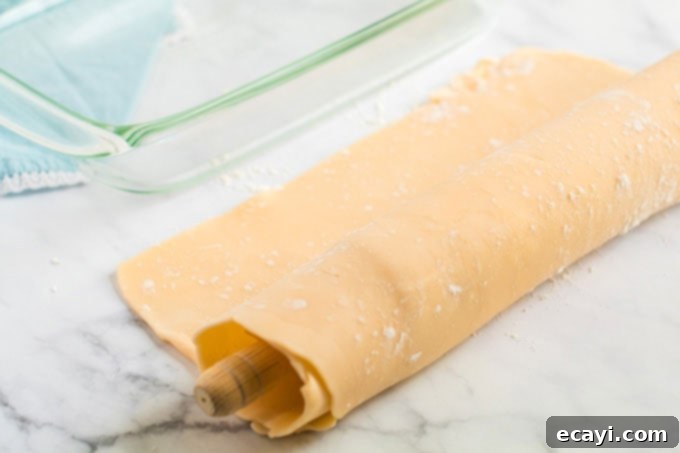
Crafting the Irresistible Peach Pie Filling
As I emphasized earlier, and it bears repeating here due to its critical importance: your fresh peaches must be very firm and only yield ever so slightly to the touch. The success of a perfectly set, not-too-runny pie filling hinges on this. If your peaches are overly soft or too ripe, they will release an excessive amount of juice during baking, which can result in a thin and watery filling that won’t hold its shape.
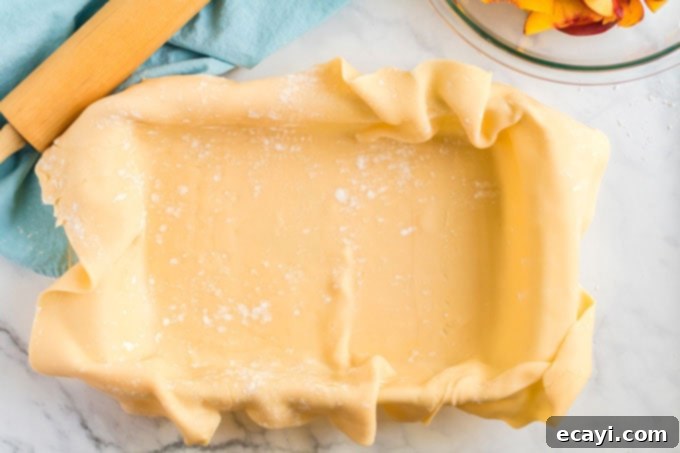
- To efficiently slice your peaches, stand each peach upright on your cutting board. Carefully slice off one side, cutting as close to the pit as possible. Rotate the peach a quarter turn and slice off the second side. Repeat this process two more times until you have four distinct peach sections, leaving the pit exposed. Now, take these sections and slice them thin, aiming for a thickness between 1/8-inch and 1/4-inch wide.
- In a separate medium bowl, combine the granulated sugar, cornstarch, cinnamon, and salt. Whisk these dry ingredients together thoroughly. This ensures they are evenly distributed and ready to create a flavorful, thickened filling. Set this mixture aside for a moment.
- Carefully arrange your freshly sliced peaches in an even layer directly into the dough-lined baking pan. Spread them out as uniformly as possible to ensure even cooking and distribution of flavor.
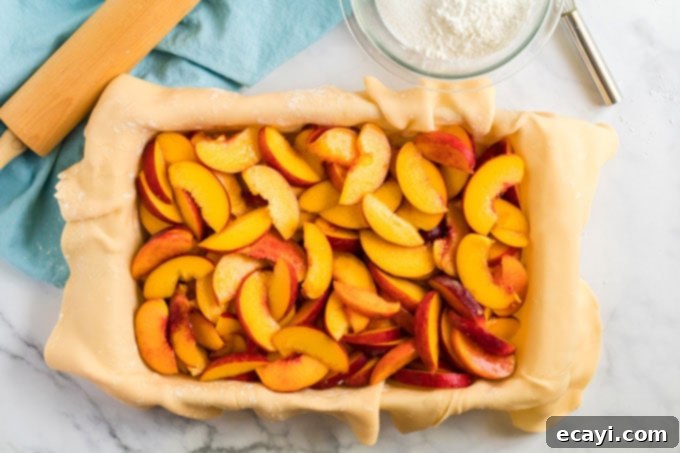
- Next, dot the surface of the peaches with the cold butter. I typically cut each tablespoon of butter into four smaller pieces to ensure more even distribution across the fruit. As the butter melts, it will contribute richness and a delightful flavor to the filling.
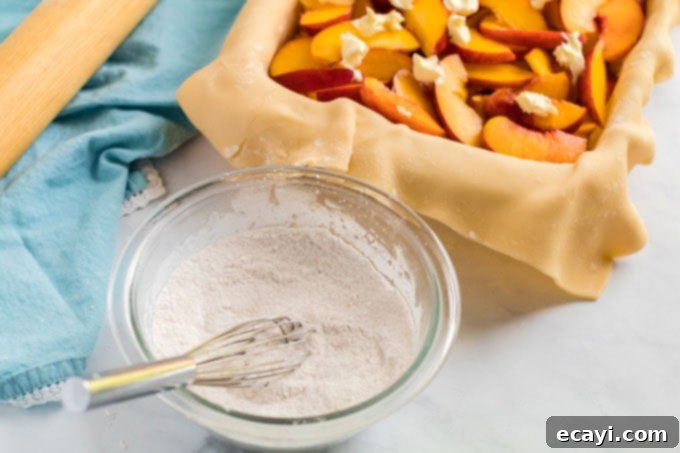
- Evenly sprinkle the reserved sugar and spice mixture over the top of the butter-dotted peaches. Make sure to cover all the peaches thoroughly, as this mixture is essential for both sweetness and thickening.
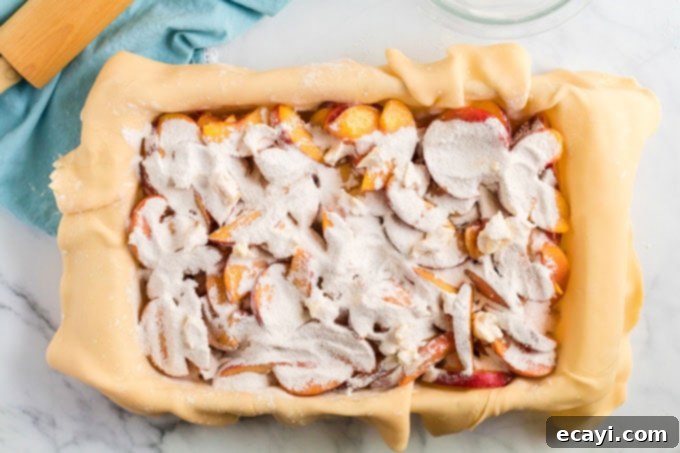
- Preheat your oven to 425°F (218°C). Allowing the oven to preheat fully ensures that the pie begins baking at the correct temperature, which is crucial for a crisp crust and a properly set filling.
- Take the remaining quarter portion of dough that you set aside earlier. On a lightly floured surface, roll it out into a rectangle approximately 10×6 inches. Then, using a pastry wheel or a pizza cutter, cut this rolled dough into 1-inch wide strips. These will form the top crust of your deep dish pie.
- Carefully place these dough strips crosswise over the peach filling. You can arrange them in a simple parallel pattern or create a more elaborate lattice design if you wish. Gently pinch the ends of the strips into place along the edge of the bottom crust to secure them.
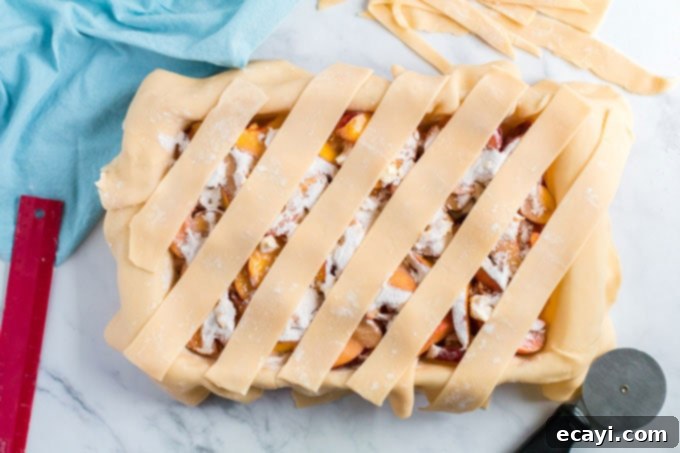
- For a neat and finished look, gently roll any excess dough hanging over the edge of the pan up under itself. This creates a slightly thicker, rustic edge that helps contain the filling and browns beautifully.
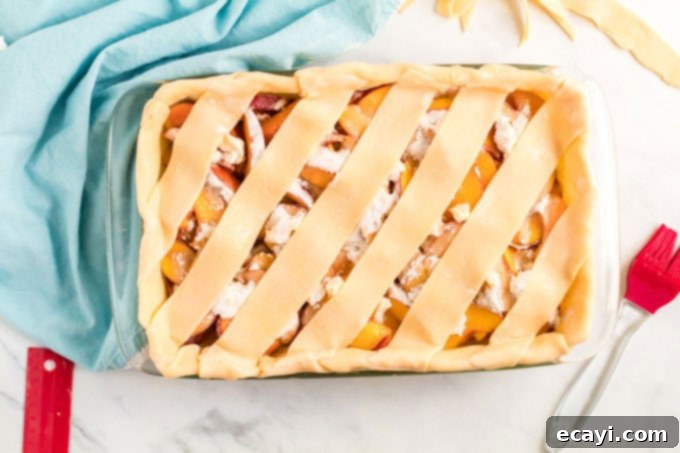
- Place your peach pie in the preheated oven and bake undisturbed for approximately 50 minutes. The pie is ready when the filling is visibly bubbly, indicating it has thickened, and the crust has transformed into a gorgeous, golden brown.
- Once baked to perfection, carefully remove the deep dish peach pie from the oven and transfer it to a wire cooling rack. Allow it to stand and cool for at least 15-20 minutes before serving warm. This cooling period helps the filling set further. A generous scoop of vanilla ice cream is the ultimate accompaniment, creating a warm and cold, sweet and creamy symphony of flavors.
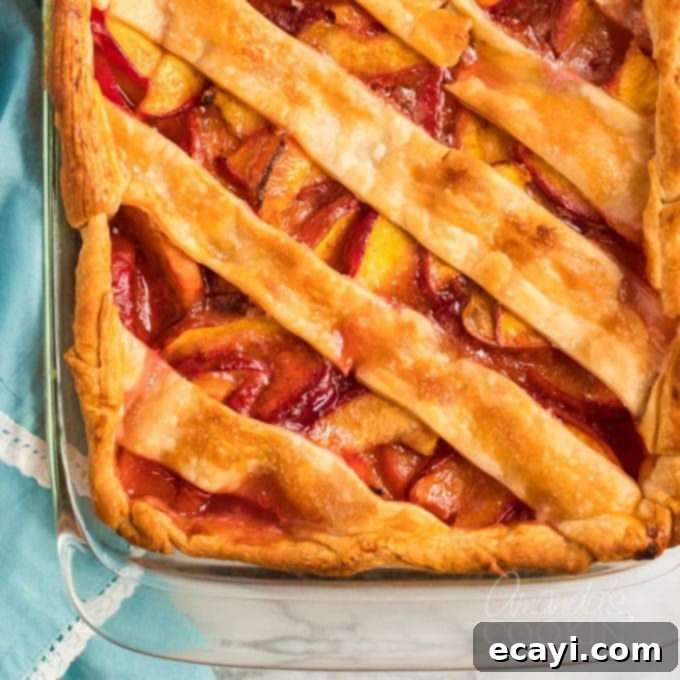
Every slice of this deep dish peach pie is a loving reminder of my mom. She passed away far too soon, back in 1990 when I was only 23 years old. While I often feel robbed of her physical presence on earth, I find solace in keeping her memory vibrant and alive through the love in my heart and, quite literally, through cherished recipes like this one. It’s a way to connect with her, to feel her spirit in my kitchen as I bake.
Several years ago, I also dedicated my classic yellow cake recipe to her memory, another staple from her culinary repertoire. These recipes are more than just food; they are echoes of her love, her generosity, and her incredible talent in the kitchen. Love you, Momma.
More Delicious Pie Recipes You Might Like
- No Bake Peanut Butter Pie
- Fresh Strawberry Pie
- Homemade French Silk Pie
- Classic Key Lime Pie
- Million Dollar Pie
- Explore all my pie recipes here for more baking inspiration.
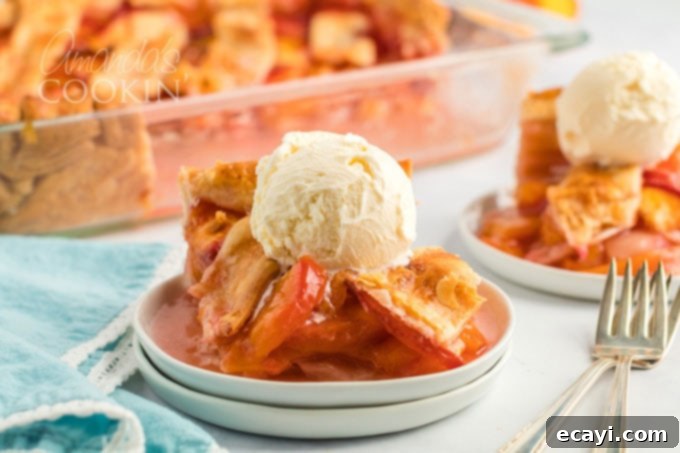
I absolutely adore baking and cooking, and I find immense joy in sharing my favorite recipes with all of you! I know it can be challenging to remember to come back and search for specific recipes, so I’ve made it incredibly easy for you with my weekly newsletter! You can subscribe for free today, and I’ll send a curated collection of delicious new recipes straight to your email inbox every week, ensuring you never miss a tasty idea.

Deep Dish Peach Pie
IMPORTANT – There are often Frequently Asked Questions within the blog post that you may find helpful. Simply scroll back up to read them!
Print It
Rate It
Save ItSaved!
Ingredients
FOR THE PIE
- 1 cup sugar
- ¼ cup cornstarch
- ½ tsp cinnamon
- ⅛ tsp salt
- 10 cups sliced peaches approximately 4-5 pounds
- 3 tbsp butter
FOR THE CRUST
- 3 cups flour
- 1 ½ tsp salt
- 1 ⅛ cup butter flavored shortening
- 7-9 tbsp cold water
Before You Begin
- Buy 5 pounds of peaches. You may not need them all, but you will definitely have enough. It all depends on the size of the peaches. The last time I made this pie, 3 1/2 pounds of peaches yielded 10 cups, the required amount for this recipe.
- This is a rustic looking crust. If you prefer a fancier look, you can create a fluted edge with your fingers.
- Let the pie bake without opening the oven. The crust will brown pretty quickly, but mine never burns. If your oven bakes on the hot side and the crust looks like it will burn, you can remove it from the oven and cover the edge (only the edges) with foil. Don’t cover the top of the pie. That will create steam, causing the strips to collapse and the filling won’t thicken properly.
- For a firmer pie that’s easier to cut, allow to cool for 2 hours. Slices can be reheated in the microwave.
Instructions
CRUST
-
In a medium bowl with a fork, stir together flour and salt.
-
Use a pastry blender (or two knifes scissor stylto cut in the shortening until mixture resembles coarse crumbs.
-
Sprinkle in water, a tablespoon at a time. Mix lightly with a fork after each addition until the dough holds together.
-
Shape the dough gently into a ball. Cut off one-fourth and set aside.
-
On a lightly floured surface with a lightly floured rolling pin, roll the remaining three-fourths of the dough into a 17×13 rectangle.
-
To lift the dough rectangle, gently roll half of it onto the rolling pin and lift it over the 13×9 glass pan. Ease it gently into the pan and up over the sides.
PIE FILLING
-
In a medium bowl combine sugar, cornstarch, cinnamon, and salt. Set aside.
-
Add sliced peaches to the dough lined pan.
-
Dot the peaches with the butter.
-
Sprinkle with the reserved sugar mixture.
-
Preheat oven to 425 F.
-
Roll the remaining dough into a 10×6 rectangle then cut into 1-inch wide strips. This is easily done with a pastry wheel or pizza cutter.
-
Place the strips crosswise over the peach filling, gently pinching them in place along the edge.
-
Roll the excess dough hanging over the edge up under itself along the edge.
-
Bake undisturbed for 50 minutes. Filling should be bubbly and crust golden brown.
-
Remove from oven to a cooling rack. Let stand for 15 minutes then serve warm.
Nutrition
The recipes on this blog are tested with a conventional gas oven and gas stovetop. It’s important to note that some ovens, especially as they age, can cook and bake inconsistently. Using an inexpensive oven thermometer can assure you that your oven is truly heating to the proper temperature. If you use a toaster oven or countertop oven, please keep in mind that they may not distribute heat the same as a conventional full sized oven and you may need to adjust your cooking/baking times. In the case of recipes made with a pressure cooker, air fryer, slow cooker, or other appliance, a link to the appliances we use is listed within each respective recipe. For baking recipes where measurements are given by weight, please note that results may not be the same if cups are used instead, and we can’t guarantee success with that method.
